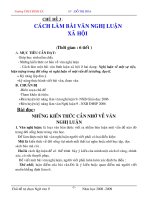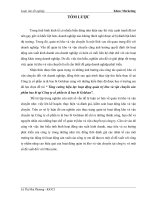Chapter 3 tầng vận chuyển
Bạn đang xem bản rút gọn của tài liệu. Xem và tải ngay bản đầy đủ của tài liệu tại đây (4.88 MB, 113 trang )
Computer Networking: A Top Down
Approach
Seventh Edition
Chapter 3
Transport Layer
Slides in this presentation contain
hyperlinks. JAWS users should be able to
get a list of links by using INSERT+F7
Copyright © 2017, 2013, 2010 Pearson Education, Inc. All Rights Reserved
Transport Layer
our goals:
• understand principles behind transport layer services:
– multiplexing, demultiplexing
– reliable data transfer
– flow control
– congestion control
• learn about Internet transport layer protocols:
– UDP: connectionless transport
– TCP: connection-oriented reliable transport
– TCP congestion control
Learning Objectives (1 of 10)
3.1 transport-layer services
3.2 multiplexing and demultiplexing
3.3 connectionless transport: UDP
3.4 principles of reliable data transfer
3.5 connection-oriented transport: TCP
– segment structure
– reliable data transfer
– flow control
– connection management
3.6 principles of congestion control
3.7 TCP congestion control
Transport Services and Protocols
• provide logical communication
between app processes running on
different hosts
• transport protocols run in end
systems
– send side: breaks app
messages into segments,
passes to network layer
– rcv side: reassembles
segments into messages,
passes to app layer
• more than one transport protocol
available to apps
– Internet: T CP and UDP
Copyright © 2017, 2013, 2010 Pearson Education, Inc. All Rights Reserved
Transport vs. Network Layer
• network layer: logical communication between hosts
• transport layer: logical communication between processes
– relies on, enhances, network layer services
household analogy:
12 kids in Ann’s house sending letters to 12 kids in Bill’s house:
• hosts = houses
• processes = kids
• app messages = letters in envelopes
• transport protocol = Ann and Bill who demux to in-house siblings
• network-layer protocol = postal service
Copyright © 2017, 2013, 2010 Pearson Education, Inc. All Rights Reserved
Internet Transport-Layer Protocols
• reliable, in-order delivery (TCP)
– congestion control
– flow control
– connection setup
• unreliable, unordered delivery: UDP
– no-frills extension of besteffort IP
ã services not available:
delay guarantees
bandwidth guarantees
Copyright â 2017, 2013, 2010 Pearson Education, Inc. All Rights Reserved
Learning Objectives (2 of 10)
3.1 transport-layer services
3.2 multiplexing and demultiplexing
3.3 connectionless transport: UDP
3.4 principles of reliable data transfer
3.5 connection-oriented transport: TCP
– segment structure
– reliable data transfer
– flow control
– connection management
3.6 principles of congestion control
3.7 TCP congestion control
Copyright © 2017, 2013, 2010 Pearson Education, Inc. All Rights Reserved
Multiplexing/Demultiplexing
Copyright © 2017, 2013, 2010 Pearson Education, Inc. All Rights Reserved
How Demultiplexing Works
• host receives IP datagrams
– each datagram has
source IP address,
destination IP address
– each datagram carries
one transport-layer
segment
– each segment has source,
destination port number
• host uses IP addresses &
port numbers to direct
segment to appropriate
socket
Copyright © 2017, 2013, 2010 Pearson Education, Inc. All Rights Reserved
Connectionless Demultiplexing
• recall: created socket has
host-local port #:
• recall: when creating
datagram to send into U DP
socket, must specify
– destination I P address
– destination port #
• when host receives U DP
segment:
– checks destination port
# in segment
– directs UDP segment to
socket with that port #
IP datagrams with same
dest. port #, but different
source IP addresses and/or
source port numbers will be
directed to same socket at
dest
Copyright © 2017, 2013, 2010 Pearson Education, Inc. All Rights Reserved
Connectionless Demux: Example
Copyright © 2017, 2013, 2010 Pearson Education, Inc. All Rights Reserved
Connection-Oriented Demux
• TCP socket identified by 4-tuple:
– source IP address
– source port number
– dest IP address
– dest port number
• demux: receiver uses all four values to direct segment to
appropriate socket
• server host may support many simultaneous T CP sockets:
– each socket identified by its own 4-tuple
• web servers have different sockets for each connecting
client
– non-persistent HTTP will have different socket for each
Copyright © 2017, 2013, 2010 Pearson Education, Inc. All Rights Reserved
request
Connection-Oriented Demux: Example (1 of 2)
Copyright © 2017, 2013, 2010 Pearson Education, Inc. All Rights Reserved
Connection-Oriented Demux: Example (2 of 2)
Copyright © 2017, 2013, 2010 Pearson Education, Inc. All Rights Reserved
Learning Objectives (3 of 10)
3.1 transport-layer services
3.2 multiplexing and demultiplexing
3.3 connectionless transport: UDP
3.4 principles of reliable data transfer
3.5 connection-oriented transport: TCP
– segment structure
– reliable data transfer
– flow control
– connection management
3.6 principles of congestion control
3.7 TCP congestion control
Copyright © 2017, 2013, 2010 Pearson Education, Inc. All Rights Reserved
UDP: User Datagram Protocol [RFC 768]
• “no frills,” “bare bones” Internet
transport protocol
• “best effort” service, UDP
segments may be:
– lost
– delivered out-of-order to
app
• connectionless:
– no handshaking between
UDP sender, receiver
– each UDP segment
handled independently of
others
• UDP use:
– streaming multimedia
apps (loss tolerant,
rate sensitive)
– D NS
– SNMP
• reliable transfer over UDP:
– add reliability at
application layer
– application-specific
error recovery!
Copyright © 2017, 2013, 2010 Pearson Education, Inc. All Rights Reserved
UDP: Segment Header (1 of 2)
Copyright © 2017, 2013, 2010 Pearson Education, Inc. All Rights Reserved
UDP: Segment Header (2 of 2)
why is there a UDP?
• no connection establishment (which can add delay)
• simple: no connection state at sender, receiver
• small header size
• no congestion control: UDP can blast away as fast as
desired
Copyright © 2017, 2013, 2010 Pearson Education, Inc. All Rights Reserved
UDP Checksum
Goal: detect “errors” (example, flipped bits) in transmitted segment
sender:
receiver:
• treat segment contents,
including header fields, as
sequence of 16-bit integers
• compute checksum of
received segment
• checksum: addition (one’s
complement sum) of
segment contents
• sender puts checksum
value into UDP checksum
field
• check if computed
checksum equals
checksum field value:
– NO - error detected
– YES - no error detected.
But maybe errors
nonetheless? More
later ….
Copyright © 2017, 2013, 2010 Pearson Education, Inc. All Rights Reserved
Internet Checksum: Example
example: add two 16-bit integers
Note: when adding numbers, a carryout from the
most significant bit needs to be added to the result
Copyright © 2017, 2013, 2010 Pearson Education, Inc. All Rights Reserved









